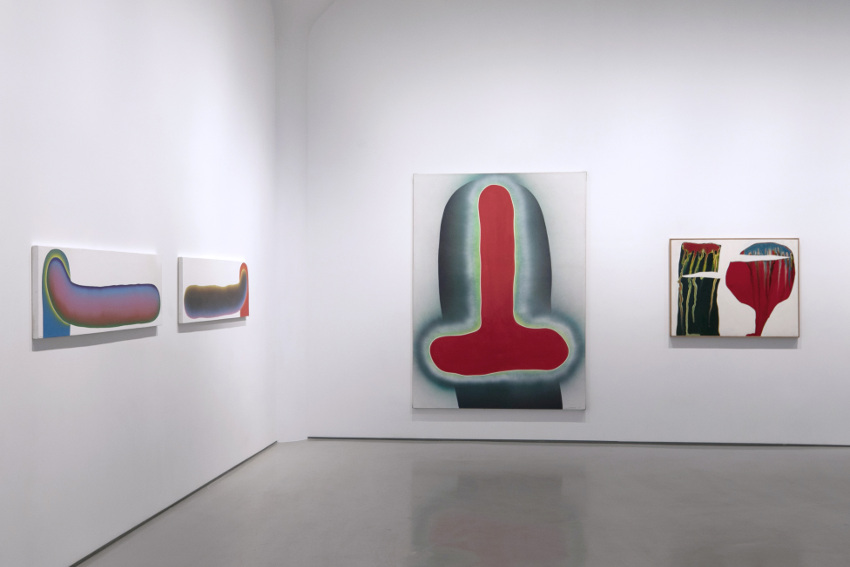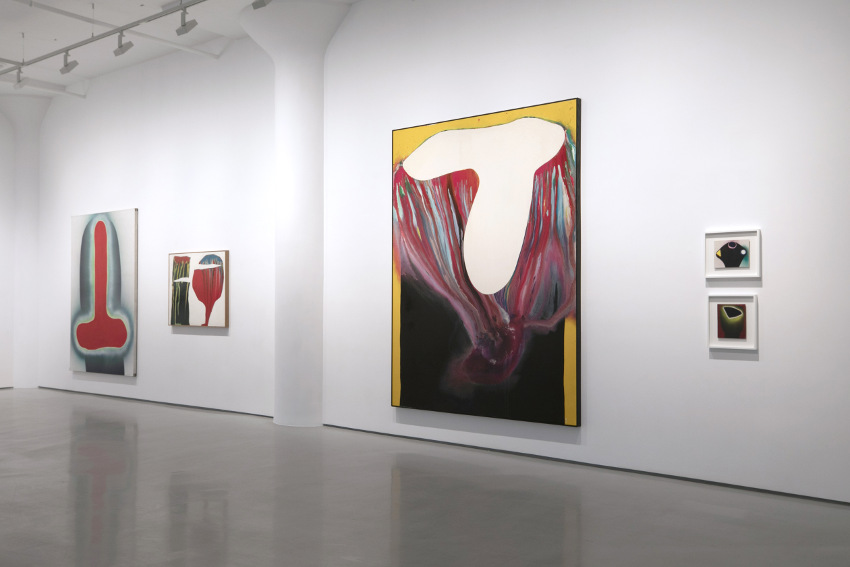
Sadamasa Motonaga, Between High and Low Art
An exhibition of mid-career abstract paintings by Sadamasa Motonaga is currently on view at McCaffrey Fine Art in New York. Motonaga was one of the earliest members of the Gutai Group, an experimental art collective that formed in Osaka, Japan, in 1954. Gutai founder Yoshihara Jiro wrote in his 1956 Gutai manifesto, “We have decided to pursue enthusiastically the possibilities of pure creativity.” Essential to the Gutai spirit was the directive from Yoshihara to do what has not been done before—a Post World War II echo of the earlier Modernist refrain to “make it new!” Motonaga established himself early on as a key member of Gutai with what Yoshihara declared the first ever water sculpture, which Motonaga exhibited in 1955 in “The Experimental Outdoor Exhibition of Modern Art to Challenge the Mid-Summer Sun,” the debut Gutai exhibition, which was held in Ashiya, Japan. The sculpture consisted of transparent plastic tubes suspended between trees. Inside each tube, Motonaga injected colored liquid that then pooled in the center. Daylight activated the colored liquid, giving it an ephemeral glow. The work temporarily gave form to the forces of the natural world. Throughout his long career Motonaga ceaselessly experimented with new mediums and techniques, but the theoretical essence of that first Gutai sculpture influenced him at every stage. He remained influenced by the shifting, organic forms of nature, the fluctuating, luminescent colors of water and light, and the invisible forces that influence everything we see, hear, taste and touch. The exhibition at McCaffrey Fine Art focuses on one specific period when the artist moved for a short period of time with his wife to New York in the late 1960s. The move brought Motonaga in touch with new techniques, such as airbrushing, and motivated him to evolve his work beyond its Gutai roots.
The Politics of Creative Destruction
The Gutai Group emerged out of a culture of confusion. The Empire of Japan had suffered a horrific defeat in World War II—the only nation on Earth to ever witness the terror of atomic destruction first hand. Certain segments of the population, especially avant-garde artists, took for granted that the ways and means of the past were no longer adequate for Japanese society. If the logic of history had led them to the brink of total annihilation then such logic must be creatively destroyed. That is what caused Yoshihara to demand newness. He did not know exactly when was needed in order to transform Japanese art and bring it into the modern day, he just knew it had to be a product not of the past, but of the imagination. One of the essential qualities of Gutai art is that it confronts the struggle between humans and the natural world. Motonaga encapsulated that struggle poetically in his water sculpture. The natural element—water—is captured and contained, and altered with artificial color: a triumph of humanity over nature. Yet the forces of gravity, sunlight, and wind tirelessly express their resistance, altering the work, shifting the dispersement of the water and the radiance of the color and light.

Sadamasa Motonaga Change/Continuity: New York 1966-67, installation view at McCaffrey Fine Art, New York, 2018. Photo courtesy McCaffrey Fine Art, New York
In his earliest paintings, Motonaga continued this conversation between human will and natural forces. He poured heavy doses of oil paint onto surfaces allowing them to pool then shifted the surface, blending the mediums into each other until fantastical compositions emerged. In with the paint he mixed gravel and other substances, transforming the texture of the work and giving the medium something to work against. Always in play was the balance between natural forces, accidents, chaos, and the control exerted by the choices and actions of the artist. The fight between artist and nature was prominently conveyed in the forms that evolved in the images. Motonaga struggled with the mediums, manipulating them as best he could until they coalesced into some kind of definitive form. Like orphaned figurative elements floating out of context in a swirling, abstract void, the forms evoke Motonaga himself, a human trying to find his place in an evolving culture.

Sadamasa Motonaga Change/Continuity: New York 1966-67, installation view at McCaffrey Fine Art, New York, 2018. Photo courtesy McCaffrey Fine Art, New York
A Change of Heart
When Motonaga moved to New York, he underwent two profound changes. First, he discovered airbrushing. This technique allowed him to radically change his surfaces from gritty, grainy, textured planes to the types of thin, airy, ethereal looking surfaces that contemporary Japanese Takashi Murakami later termed “super-flat.” In his Superflat compositions, Motonaga exerted a completely different relationship with control. No longer was he making paintings that highlighted the struggle between artist and physical nature. The new struggle in his work was between artist and the nature of imagination. His choices were now being more closely scrutinized. The second profound change in his life was that while in New York his wife gave birth to their first child. Motonaga was suddenly inundated with the visual world of books, toys, and other products intended for children. The whimsy and optimism of that visual language guided the choices he made in his paintings, bringing forth a body of work full of jovial, biomorphic abstract forms that approximate things like human body parts, vegetables, aircrafts, and submarines.

Sadamasa Motonaga Change/Continuity: New York 1966-67, installation view at McCaffrey Fine Art, New York, 2018. Photo courtesy McCaffrey Fine Art, New York
Although this major shift in his work troubled many of the supporters who had previously collected his paintings, Motonaga stayed true to the most important point of his Gutai roots: the final autonomy of the artist to make whatever kind of work they want, and not to be tied to the ways of the past. The legacy of his transformative time in New York influenced generations of Japanese artists who carry on his aesthetic vision not only in the world of fine art, but also in the so-called low art world of manga and anime. The bridge between these two worlds that Motonaga created is especially powerful because of the intense emotion that his paintings often convey. Not only are they full of whimsy and joviality, they frequently also evoke loneliness, isolation, and fear. They are proof that even though Motonaga evolved far beyond the Gutai roots of his early career, the anxiety that defined that generation was never truly far behind. “Sadamasa Motonaga Change/Continuity: New York 1966-67” is on view through 21 December 2018 at McCaffrey Fine Art in New York.
Featured image: Sadamasa Motonaga Change/Continuity: New York 1966-67, installation view at McCaffrey Fine Art, New York, 2018. Photo courtesy McCaffrey Fine Art, New York
By Phillip Barcio






